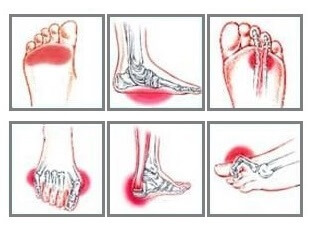- Home
- Foot Pain Symptoms
- Foot Rashes
Foot Rash Problems
Written By: Chloe Wilson BSc(Hons) Physiotherapy
Reviewed By: FPE Medical Review Board
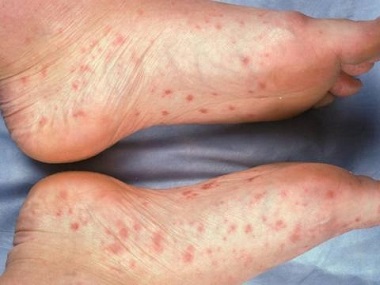
A foot rash can be caused by a whole range of things such as an allergic reaction, infection or underlying medical condition.
Symptoms of foot or ankle rashes vary from anything from a small, short-lived, mild rash on feet to one that spreads up the leg, returns frequently and is painful or itchy.
Accurate diagnosis of foot and ankle rashes is essential to ensure effective treatment and prevent skin rashes from spreading, worsening or becoming chronic (long-term).
What Can Cause A Rash On My Feet?
There are a number of different causes of a foot rash which all present slightly differently and therefore require different treatment. The most common causes of rashes on feet are:
- Contact Dermatitis: Irritant or Allergic
- Eczema: aka Atopic Dermatitis
- Athletes Foot: aka Tinea Pedis
- Hand, Foot & Mouth Disease: common in children
Let's have a look at each of these and how to treat them and then we'll go on to look at some of the other possible causes of foot rashes.
1. Irritant Contact Dermatitis
An allergic reaction that causes a foot rash is known as contact dermatitis and develops when the skin is sensitive to certain substances. There are two types of contact dermatitis skin rash on feet, the first being Irritant Contact Dermatitis:
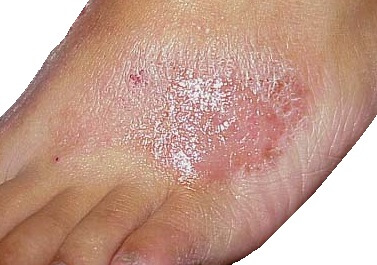
Causes: Damage to the protective outer layer of skin, usually due to contact with chemicals such as household cleaning products, detergents, dyes, cosmetics or industrial chemicals. This is the most common type of contact dermatitis.
Symptoms: Localised dry, cracked, scaly skin and a non-itching foot and ankle rash. Symptoms vary according to the length of exposure, the amount and potency of the irritant.
Treatment: Wash the area well, avoid the irritant, anti-histamines and topical steroids. LEARN MORE >
2. Allergic Contact Dermatitis
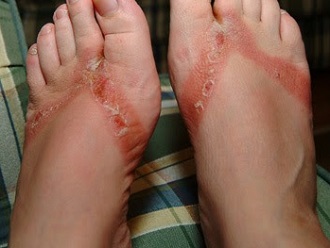
The other type of contact dermatitis causing a foot or ankle rash is Allergic Contact Dermatitis
Causes: Exposure to allergens trigger an immune reaction in the skin causing rash on feet. Common allergens include latex rubber, plants e.g. poison ivy, metallic substances e.g. nickel and chromates e.g. in shoe leather.
Symptoms: This type of foot rash usually presents as pink or red skin with small bumps or spots on feet which may blister. There tends to be extreme itching from these skin rashes.
Treatment: Avoiding the allergen, cold compress, anti-histamines, topical steroid cream. LEARN MORE >
A rash on the foot or ankle from contact dermatitis may develop from a single exposure or after repeated episodes of contact. Foot rash symptoms from contact dermatitis usually appear within a few minutes to hours of exposure and can last for 2-4 weeks. Spots on feet from contact dermatitis are not contagious.
3. Eczema aka Atopic Dermatitis
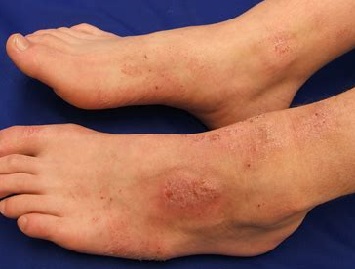
Eczema is another cause of a foot or leg rash. It is a chronic condition that usually starts in early childhood. Many children grow out of eczema but it can persist into adulthood.
Atopic dermatitis affects approximately 25% of children and 2-10% of adults and is becoming an increasingly common cause of rashes on feet.
Causes: The exact cause of foot eczema is unknown and it may be due to a number of factors including an inability for the skin to provide an effective barrier to allergens, bacteria on the skin and environmental conditions. There is a genetic link with eczema and it is often accompanied by allergies and hay fever. Stress and anxiety can cause flare ups.
Symptoms: Dry, red patches of inflamed skin. Often itchy ankles and feet, especially at night. Can progress to small, fluid filled spots on feet. A skin rash from eczema often occurs in skin creases such as behind the knees or between the toes.
Treatment: There is no cure for foot eczema but there are things you can do to reduce the symptoms of the leg or ankle rash including corticosteroid cream or ointment (ointment tends to be more effective), anti-histamines, UV light therapy. LEARN MORE >
Regularly moisturise the feet (at least twice a day) to help reduce the chance of your foot rash flaring-up. Reduce the frequency and length that you bathe or shower, use warm rather than hot water and use emollients such as Aveeno instead of soap in the water to prevent the skin drying out with eczema.
Eczema tends to flare up periodically and then subside for anything from a few days to years. A foot or ankle rash from eczema is not contagious.
You can find out loads more about the different types of eczema and how to treat them in the Foot Eczema section.
4. Athlete's Foot aka Tinea Pedis
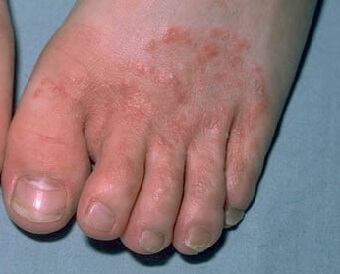
Athlete’s foot, a type of ringworm, is a fungal infection that usually starts with a foot rash between the toes known as a ringworm rash.
Tinea Pedis affects approximately 15% of the population and is more common in men.
Causes: Sweaty feet, tight shoes, damp footwear – anything that makes the foot warm and wet for long periods
Symptoms: Scaly, flaky, itchy, red rash on top of foot (aka a ringworm rash) accompanied by stinging and burning sensation. Blisters can develop
Treatment: Anti-fungal medication – usually cream or ointment or in severe cases oral medication. Good hygiene measures such as regularly changing socks and shoes, or wear sandals to prevent excessive moisture at the foot. LEARN MORE >
Athlete’s foot is a contagious foot rash and is spread by skin-to-skin contact or through contaminated surfaces e.g. floors, towels and clothing
5. Hand, Foot & Mouth Disease
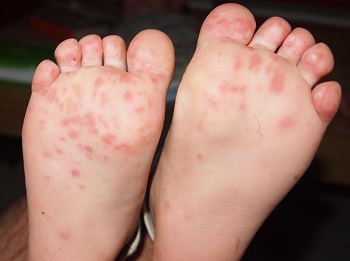
Hand, foot and mouth disease is a mild viral infection which causes a mouth, hand and foot rash. It mainly affects children under the age of 10.
Causes: Infection from the coxsackievirus A16. Highly infectious, through nasopharyngeal secretions from coughing and sneezing.
The incubation period (time from exposure to symptoms) is usually 3-6 days. Tends to occur during warmer weather.
Symptoms: Red bumps on feet, non-itchy hand and foot rash (on the soles of the feet). Blisters in the mouth, hands and feet. Fever, sore throat, loss of appetite and a general feeling of being unwell. Dehydration is a common side effect as it can be extremely painful to drink.
Treatment: Treatment for hand, foot and mouth disease is geared towards symptom relief. Oral anaesthetics can make swallowing more comfortable and over the counter medications such as paracetamol and ibuprofen can help relieve discomfort. Symptoms usually settle within a few days.
NB Not to be confused with foot and mouth disease in animals which is from a completely different virus. Hand, foot and mouth cannot be caught from or passed on to animals.
Other Foot Rash Causes
There are a number of other possible causes of rashes on feet, but they tend to be less common or affect more of the body, rather than being confined to the foot or lower legs.
1. Psoriasis
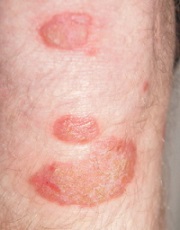
Psoriasis is a chronic skin disease causing red, scaly, itchy patches. Skin rashes from psoriasis are caused by rapid overproduction of skin cells due to a problem with the immune system. Psoriasis skin lesions range from small, localised patches to major eruptions affecting the whole body.
Skin rashes from psoriasis tends to occur on the soles of the feet. It affects 2-4% of the population. Symptoms usually go through recurrent cycles of flaring up for a few weeks or months then settling down.
2. Scabies
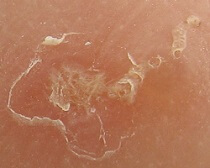
Scabies is a contagious skin condition caused by a parasite burrowing under the skin. Scabies affects 1.5% of the population and causes intense itching which is worse at night.
Superficial burrows from the mite are visible through the skin, with the foot rash appearing in lines accompanied by small, red spots commonly in the webs of fingers and toes.
3. Insect Bite
A bite to the foot or ankle can produce a skin rash. It tends to be a small, localised spot or group of spots which are itchy and the foot rash settles within a few days.
4. Medical Conditions
Some other medical conditions can cause a foot, ankle or leg rash include Lyme Disease, meningitis, lichen planus, chicken pox, shingles, and rheumatoid arthritis.
Foot Rash Treatment
There are a number of different options for foot rash treatment, depending on the underlying cause:
- Contact Dermatitis: Topical corticosteroids, anti-histamines, wash area well, avoid irritant, cold compress
- Eczema: Topical corticosteroids, anti-histamines, moisturisers, emollients and UV phototherapy
- Infections: Anti-fungal medication, good foot hygiene
We look at each of these in-depth and how to work out which is best for you in the foot & ankle rash treatment article.
When Is An Ankle Rash Serious?
If you are suffering from a rash on your feet or ankles, it is always a good idea to get it checked out by your doctor, especially if it last for more than a few days or is getting progressively worse.
Your doctor will examine the foot, leg or ankle rash and ask questions such as when it began, if you’ve been taking any medications, eaten something disagreeable, used any new products e.g. soaps, if there is any associated itching or scaling with your skin rash, if you’ve spent lots of time outdoors and how your general health is.
They will then be able to advise on the best course of treatment for your foot rash.
Foot Rash Summary
Foot rashes can be caused by a variety of factors, such as allergic reactions, fungal infections, contact dermatitis, eczema and bacterial or viral infections.
Common symptoms associated with rashes on feet include redness, itching, burning, flaking, blistering, and scaling of the skin. In some cases, the foot rash may become infected and cause pain, swelling, and discharge.
Treatment for foot rashes depends on the underlying cause. Common foot rash treatments may include topical creams or ointments, oral medications, or light therapy. It is important to seek medical attention to get an accurate diagnosis and appropriate treatment plan.
There are lots of other causes of lumps and bumps on the feet so if none of these is sounding like your problem, check out the Foot Lumps article.
You may also be interested in the following articles:
- Pain On Top Of Foot
- Foot Arch Pain
- Nerve Pain In The Foot
- Swollen Feet & Ankles
- Foot Numbness
- Lumps On Toes
- Thick, Yellow Toenails
Related Articles
Page Last Updated: 03/09/23
Next Review Due: 03/09/25
